An adaptable and simple-to-grow yarrow plant can be employed in a variety of garden settings. Due to its ability to draw in helpful insects and ward off dangerous pests, it is also a fantastic companion plant for many garden crops. Certain plants, meanwhile, could not be good companion plants for the yarrow plant.
Not only is yarrow aesthetically pleasing, but it also attracts pollinating bees and other beneficial insects, making it a great companion plant for many other species.
However, not all plants are companion plants for yarrow that’s why you have to know what not to plant with yarrow, as some can compete for resources or attract harmful insects.
In this article, we will explore what not to plant with yarrow and companion plants for yarrow, as well as some tips for optimizing their growth and health in your garden.

Which plants ought to be kept away from yarrow?
The hardy and adaptable yarrow plant (Achillea millefolium) is a relatively simple plant to grow. To guarantee the growth and health of the yarrow, some plants should be kept away from planting areas near it.
Wormwood (Artemisia absinthium) is not a good companion plant it should be kept away from yarrow because it can emit chemicals that stunt the growth of other neighboring plants.
Ruta graveolens, another plant to stay away from, have a similar impact on nearby plants.
Brassica family plants including broccoli, cauliflower, and cabbage should also be kept away from yarrow because they are not good companion plants.
These plants exude compounds that may inhibit the growth of nearby yarrow and other plants.
Mint and yarrow can fight with one another for nutrients and water, and mint can swiftly grow and smother nearby plants, therefore some gardeners advise against planting it close to yarrow.
As for the dog fennel genus, it is necessary to take precautions when planting seeds to ensure their growth and development are not hindered. Avoid planting it alongside the dog fennels, as they can hurt the yarrow.
Consult a local gardening professional or resources tailored to your area if you are unclear about the plants that will grow the best in your garden.
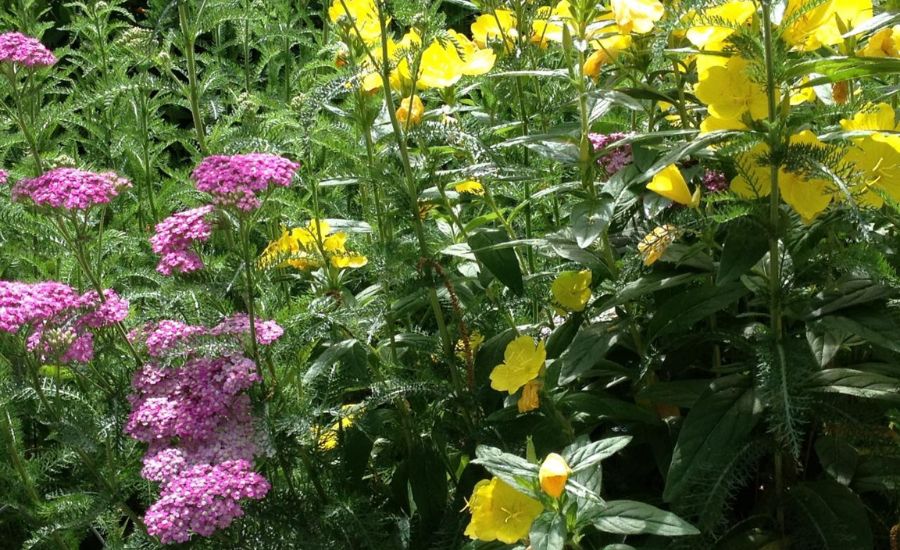
Things to consider when planting in yarrow
Here are a few things to consider when planting with yarrow:
Plants that need moist soil
It is a plant that does not require moist soil, but needs well-drained soil and cannot withstand soggy or damp conditions.
For plants that need moist soil, such as bog-loving plants or water plants, it might not be the greatest companion plant.
Slow-growing plants
Yarrow is a fast-growing plant that can easily take root in a garden. Yarrow may soon surpass slower-growing plants, such as some groundcovers or small perennials if they are planted alongside it.
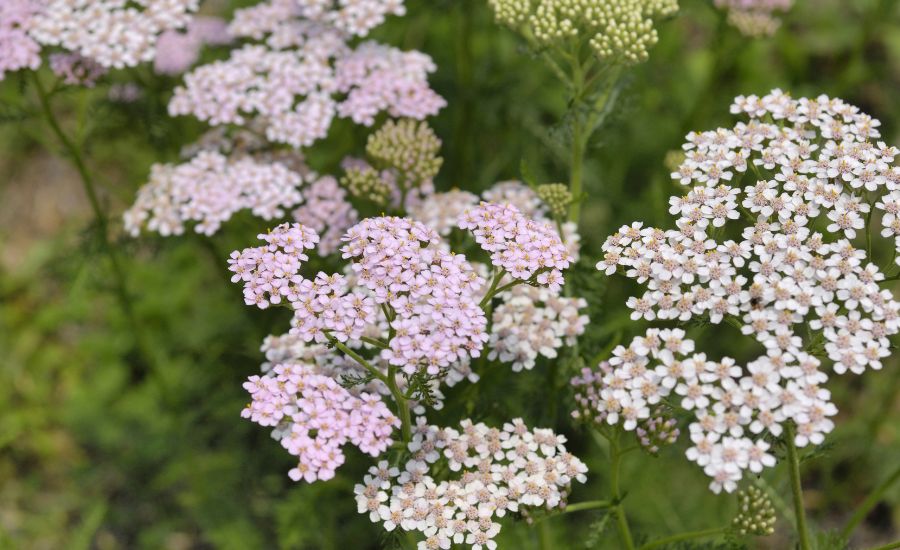
Plants that are sensitive to root competition
Yarrow may grow quickly and compete with other plants for nutrients and water because it has a fibrous root system.
For delicate or slowly growing plants that are vulnerable to root competition, it might not be the greatest companion plant.
Plants that require full shade
Sun-loving plants like yarrow do best in the sun or light shade. As a result, it might not be a good companion plant for ferns or mosses that require complete shade.
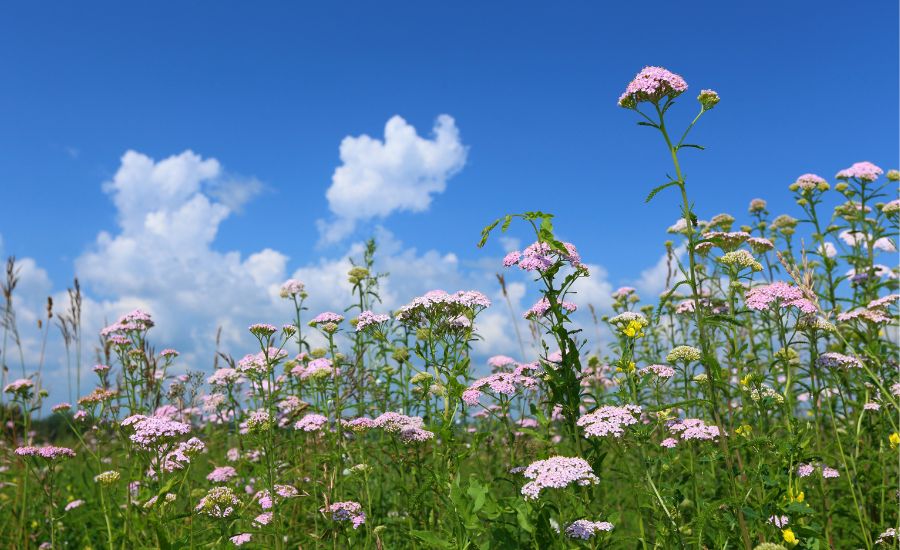
How to plant yarrow?
A resilient and low-maintenance plant that is comparatively simple to grow is yarrow (Achillea millefolium). These are some guidelines for planting:
Choose a location. Yarrow does best in sun, but will also grow in light shade. Choose a spot in your garden that gets at least 6 hours a day of direct sunlight.
Avoid planting yarrow in locations that are prone to standing water because it also likes well-draining soil.
Prepare the soil. Yarrow enjoys a pH range of 6.0 to 7.5 and a slightly alkaline environment. Yarrow appreciates soil that is rich in organic matter, so adding compost or old manure to the soil can increase its richness. If your soil is too acidic, you can add lime to boost the pH
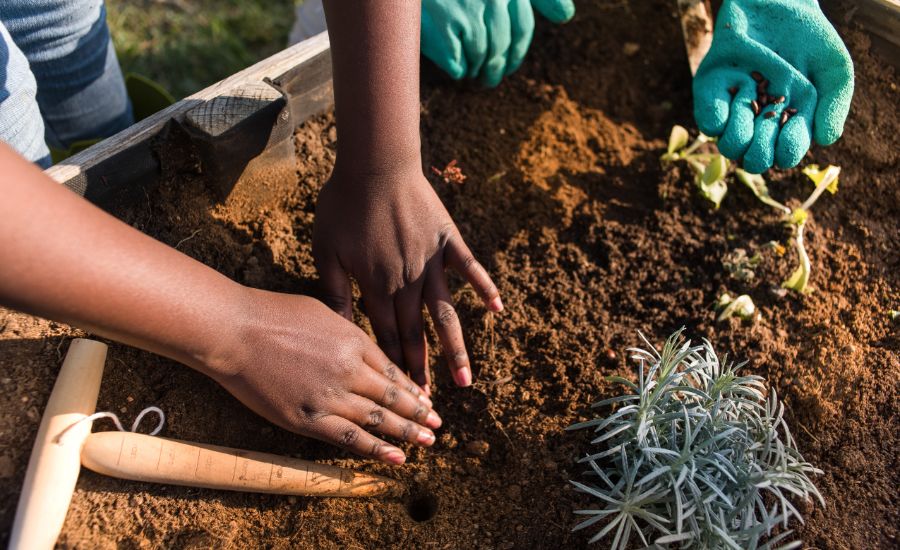
Plant the yarrow. Both seeds and transplants can be used to plant the yarrow. If starting from seed, plant the yarrow seeds in the ground directly in the early spring or fall, softly covering them with soil.
Dig a hole in the ground slightly bigger than the plant’s root ball when planting transplants. Backfill the hole with soil, gently compacting it around the plant after placing it in it.
Water the yarrow regularly but not too much because it can withstand drought and doesn’t need to be watered frequently. During dry spells, water the plant well once a week. Avoid overwatering, though, as this can lead to the rot of the roots.
Mulch around the yarrow plant’s base to prevent weeds from growing and to help the soil retain moisture. Apply a thin layer of organic mulch, like straw or chopped leaves, taking care not to cover the plant’s crown.
Care for the yarrow. Grow yarrow doesn’t need a lot of attention and upkeep. Regularly deadhead the spent flowers to promote new blooms and stop self-seeding. To get the plant ready for winter, trim it back to the ground in the fall.
Following these steps can help you successfully plant and care for the yarrow in your garden.
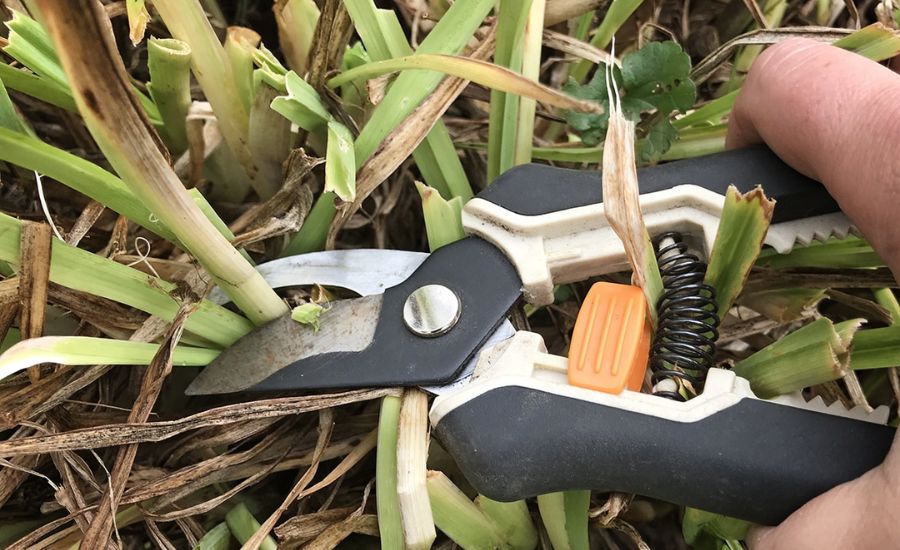
FAQ
Can yarrow be planted with vegetables?
Yarrow can be grown in a vegetable garden. In reality, there are several advantages to combining yarrow with veggies.
It’s crucial to select a spot for yarrow growing with veggies that receives full sun and has well-drained soil. Yarrow can be cultivated as a border around the garden bed or between vegetable rows.
Ladybugs, lacewings, and hoverflies, which can help manage pests in the garden, are known to be attracted to yarrow. These insects can consume common garden pests like beneficial aphid-eating insects and spider mites, helping to maintain the health and pest-free status of your plants.
It’s also crucial to keep in mind that while yarrow is often a low-maintenance plant if not properly contained, it can grow swiftly and become invasive. You can avoid this by growing yarrow in containers or a specific section of the garden where it won’t get in the way of your vegetable plants.
Moreover, you can successfully grow tomato plants alongside common yarrow without putting the health of your garden at risk. Planting alongside provides an extra layer of protection to a common yarrow.
What can I plant next to yarrow?
The herb yarrow (Achillea millefolium) is useful for a variety of garden plants.
It is an excellent companion plant for a variety of crops since it draws helpful insects and wards off destructive pests. Good yarrow companion plants include:
Chamomile. This herb enhances the flavor of neighboring plants and aids in repelling dangerous insects.
Dill. Dill attracts helpful insects that help manage pests, like ladybugs and lacewings.
Parsley. Due to its ability to draw in beneficial insects and enhance soil quality, parsley makes a wonderful companion plant for yarrow.
Garlic. Garlic is a natural insect repellent that can help protect neighboring plants from hazardous insects.
Catnip. Catnip can enhance the quality of the soil by luring beneficial insects like bees and butterflies.
Many different plants can make good companion plants for yarrow, including deer-resistant plantings that are a great option for gardeners looking to protect their yarrow plants from deer damage. Some yarrow companion plants that can be planted alongside yarrow include lavender, salvia, and black-eyed Susan.
Lavender. Although they both do well in full sun, yarrow and lavender herb-like well-drained soils make them great companion plants.
Bee balm is a flowering herb that is not only visually appealing in the garden but can also be beneficial to yarrow companion plants. It attracts pollinators such as bees and butterflies, which can help to increase the yield and quality of yarrow flowers.
Salvia. Salvia and yarrow both prefer dry soil conditions and can tolerate hot, sunny locations. They also have similar water needs, making them good companions in the garden.
Black-eyed Susan. Black-eyed Susan and yarrow require equal amounts of watering and can both withstand hot, dry weather. Its vivid yellow blossoms can produce a beautiful color scheme in the garden.
To guarantee that yarrow and your chosen companion plant will coexist successfully in your garden, it is often better to select plants with comparable growing requirements. Companions Yarrow is a great companion plant for many vegetable and fruit plants.
What herbs and plants are the worst companions for yarrow?
Also, several plants can not be companion plants for yarrow. They consist of:
Brassicas. Plants that are brassicas, such as broccoli, cabbage, and kale, are susceptible to damage by cabbage moths, which can be drawn to yarrow.
Mint. Because yarrow and mint have comparable requirements for growth, planting them together may result in resource competition and growth inhibition.
Fennel. While it attracts useful insects, fennel also releases toxins that stunt the growth of neighboring plants, which can be harmful.
What should I plant in front of yarrow?
A lovely and adaptable herb, yarrow can be used in a variety of garden settings. It can be utilized in borders, rock gardens, or as a background for other plants. It has gorgeous foliage and flowers. Depending on your garden’s layout and preferences, you have a variety of options for planting in front of the yarrow. Here are a few concepts:
Low-growing herbs: You may make a lovely herb garden display by planting thyme, oregano, or creeping rosemary in front of the yarrow. These plants will go well with the yarrow’s flowers and foliage and make excellent border edging.
Annual flowers: Putting annual flowers in front of yarrow, such as petunias, marigolds, or zinnias, can offer a splash of color and make for a lovely contrast. Also, these blooms are fantastic in luring pollinators to your yard.
Succulents: In front of the yarrow, planting low-growing succulents like hens and chicks or sedum can produce a lovely and low-maintenance garden show. These plants also provide your garden texture and intrigue.
Will yarrow choke out other plants?
While yarrow is not known to choke out plants, it’s significant to choose companion plants carefully and consider their growth requirements. Some plants may require more nutrients and don’t need full sun than others, which can lead to competition and stunted growth.
Additionally, some plants may attract damaging insects that can damage yarrow plants. By carefully selecting companion plants that are well-suited to grow alongside yarrow, you can help create a thriving ecosystem in your garden.
Can you plant yarrow under trees?
It is possible to plant yarrow (Achillea millefolium) beneath trees, however, it relies on the tree’s kind and the individual growing circumstances.
The yarrow plant enjoys full light and prefers soil that drains well. The yarrow may not thrive as well as it would in full sun if the tree casts a lot of shade.
The root rivalry between the trees and the yarrow plants is another factor to take into account. It might not be the greatest location to grow yarrow if the soil beneath the tree is already extensively populated by the tree’s roots.
Having said that, yarrow may make a wonderful accent to a garden in some tree kinds. It might be possible for the yarrow to flourish if the tree offers filtered or dappled shade. The yarrow might also get more sunlight during the dormant season if the tree is deciduous, which means it loses its leaves in the winter.
It’s also important to remember that the yarrow plant is a hardy plant that can survive in a range of soil conditions, even those with low nitrogen levels.
But, it’s not recommended to plant apple trees as nearby plants for yarrow companion planting, as apple trees are susceptible to powdery mildew, and the perennial flowering herb yarrow may spread the disease.
One should avoid planting fruit trees susceptible to powdery mildew as companion plants to the perennial herb yarrow in early spring. This is because yarrow plants can spread the disease, which can harm fruit trees. It’s significant to be mindful of what not to plant with yarrow to ensure a healthy garden.
Conclusion
Although yarrow is an excellent companion plant for many garden crops, it’s crucial to take into account the unique requirements and growing yarrow circumstances of the plants you’re planting with it. You may make a lovely and healthy garden by picking the right companion plants and spacing them properly.
Good companion plants for yarrow include aromatic herbs, butterfly gardens, and plants that attract pollinators and beneficial insects. Yarrow will put more nutrients in the soil and attract pollinators.
Avoid growing yarrow with plants that have different growth requirements or that attract destructive insects. In addition, avoid growing crops because they are susceptible to powdery mildew and so is yarrow, and if they get powdery mildew there are fair chances that all of them (including yarrows) will be affected by this fungal disease, as it spreads very fast.
Read More: 13 Yarrow Companion Plants


